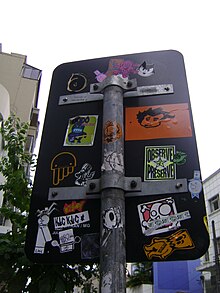Sticker
show This article may be expanded with text translated from a corresponding article in another language. (August 2021) Click [show] for important translation instructions. |



A sticker is a type of label: a piece of printed paper, plastic, vinyl, or other material with pressure sensitive adhesive on one side. They can be used for decoration or for functional purposes, depending on the situation.
Stickers can come in many different shapes and sizes and also vary widely in color and design. They are often adhered to items such as lunchboxes, paper, lockers, notebooks, walls, cars, windows, and so on. Temporary name tags for example are frequently stickers.
Stickers are very widely used when an object requires identification with a word or idea. Brand stickers may be attached to products to label these products as coming from a certain company. They may also be used to describe characteristics of the products that would not be obvious from simple examination, or to clarify either a printing error or change in the product of some kind, such as the country of origination, shift in a product's ingredients, a shelf life date, or copyright notice, without having to scrap pre-existing packaging for such a small change. A label dispenser is often used as a convenient way to separate the sticky label from its liner or backing tape.
Stickers placed on automobile bumpers, magnetic and permanent, called bumper stickers, are often used by individuals as a way of demonstrating support for political or ideological causes. Identification of vehicle registration and last service details are two examples of stickers on the inside of most car windscreens. The term "window sticker" is generally used for vinyl labels which are stuck to the inside of a vehicle's window, as opposed to water-resistant stickers that are stuck to the outside of a vehicle but can be affixed to anything.
Stickers are also used for embellishing scrapbooking pages. Kinds of stickers sold for this purpose include acrylic, 3D, cardstock, epoxy, fabric, flocked, sparkly, paper, puffy, and vellum. While in the earlier days of scrapbooking stickers were sold mostly on 2"x6" sheets, now[when?] 6"x12" and even 12"x12" size sheets are very common.
They are frequently distributed as part of promotional, and political campaigns; for example, in many voting districts in the U.S., stickers indicating an individual has voted are given to each voter as they leave the polling place, largely as a reminder to others to vote. Observers may clap hands, honk a horn or otherwise applaud a good sticker.
Forming a partnership with FIFA in 1970, Panini first produced a World Cup sticker album for the 1970 World Cup.[1][2] Initiating a craze for collecting and trading stickers, since then, collecting and trading stickers has become part of the World Cup experience, especially for the younger generation.[3][4] UK newspaper The Guardian states, “the tradition of swapping duplicate [World Cup] stickers was a playground fixture during the 1970s and 1980s.”[3]
Stickers placed on tires, usually called tire lettering, can be temporary or permanent. These spell out names or have graphics on them, to enhance the look of the car.
History[]
This section needs expansion. You can help by . (July 2019) |
R. Stanton Avery is credited with creating the first self-adhesive sticker in 1935.[5]
Collecting[]
Collecting stickers may be popular. As they provide big variety and are not expensive, stickers are beginner-friendly collectables. Because they are easy to collect, stickers often act as an introduction to collecting hobby for children.
See also[]
- Decal
- Pressure-sensitive tape
- Prizes
- Release liner
- Sticker album
- Sticker (Internet) – emoticon-like pictures
References[]
- ^ "Brand collaborations". FIFA.com. Retrieved 8 September 2018.
- ^ "Panini World Cup 2018 stickers: When is the iconic sticker album release date? And how much will it cost?". London Evening Standard. Retrieved 8 September 2018.
- ^ Jump up to: a b "Panini World Cup sticker book". The Guardian. Retrieved 3 September 2018.
- ^ “The Magic, Global Craze and Tradition of Panini's World Cup Sticker Albums”. Sports Illustrated. Retrieved 2 September 2018
- ^ "Who Invented Stickers?". Wonderopolis. Retrieved 25 July 2019.
External links[]
| Wikimedia Commons has media related to Stickers. |
- Articles needing translation from foreign-language Wikipedias
- Stickers
- Stationery
- Ephemera
